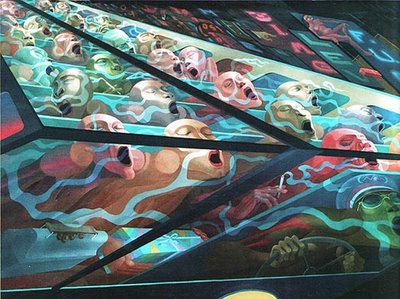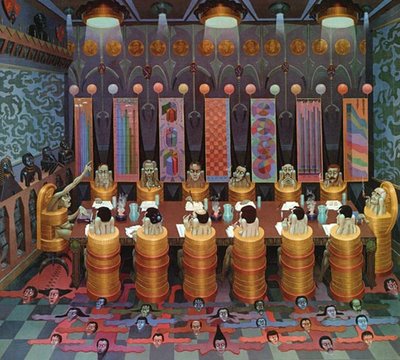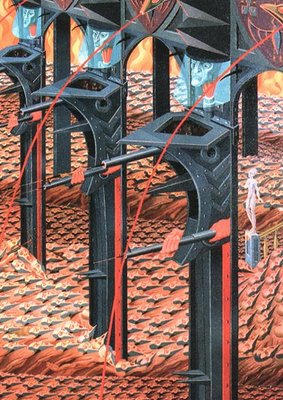Inside the Artist's Mind: More on Irving Norman

To Have and Have Not (Charity Gala) © Irving Norman 1979-80
(Click on image for larger view).
All images in this series are presented with Hela Norman's permission.
Here is part two of the interview artist Roberta Loach did with Irving Norman back in 1975. I hope you're enjoying this rare peek inside the mind of a phenomenal artist.
Roberta Loach: You haven't had a great deal of what most people would call "success" have you? You are doing well now in sales and acclaim., but it's been a long time coming. So, what's kept you going? What's kept you surviving as an artist?
Irving Norman: Do you mean materially?
RL: No. That's always implicit, so I'm not really concerned with that.
IN: Well...I don't know...just the determination to do something good. I observe life and it turns me on and I have to give it expression.
RL: And you can't not do so?
IN: Yeah...I wouldn't feel well if I couldn't. The big problem is to find what it is you want to do and get as deep as you can go to the truth of things and not hesitate to tell it...no wishy washy stuff...no consideration of anyone in the art world or audience. With me it's just pure self expression. That's my nature just as it was with Jackson Pollock. Curators don't see it that way. They see self expression if it's abstract and if you express yourself in the way I do, they even go so far as to call it propaganda.
RL: Why do you think they feel that way?
IN: It relates to what we talked about earlier...they become part of an establishment. A great deal of it has to do with the fact that they are in a groove. They make a living at it. The atmosphere is conductive to continuing in that way of life. The board of directors, the critics, the whole milieu subconsciously makes them take their safe position. They want to keep their jobs.
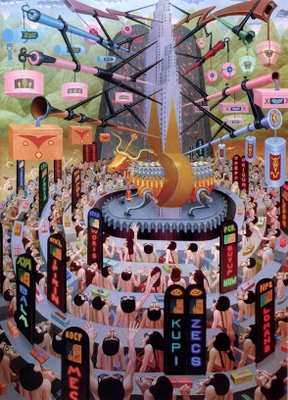
Golden Calf 2 © Irving Norman 1985
(Click on image for larger view).
All images in this series are presented with Hela Norman's permission.
RL: What do you so to people who say of your work..."Oh that's been done before."
IN: I would like them to show it to me.
RL: But a lot of the types of statements you make have been made before. E.G. Goya, Beckmann, Grosz, etc.
IN: But that's in the past. What these critics of my work don't see is that life is completely new and different with each era and these concepts have to be renewed...looked at anew.
RL: And your statements related to your time?
IN: I hope so. It would be nice to think so. That's why I'm concerned with preserving some of my better things. For that reason I would like some museums to take them and keep them to exhibit at a later date as a record of our time.
RL: On that subject, you haven't fared too well with museums have you?
IN: No.
RL: What answers have they given you as to why they aren't interested in your work?
IN: They say it just doesn't fit in.
RL: It's not within the trend?
IN: That's the word they use...They say they are sorry but they have work planned two years in advance, and mine just doesn't fit in. Yet local critics, Frankenstein and Fried have been very good to me. Frankenstein tried to get me a show at the Whitney and they kept my photographs for God knows how long. Mrs. Miller of the Museum of Modern Art gave me an honorable mention in a show and asked me to submit a number of drawings to the museum. She hoped they would accept some for their collection, but the board of trustees wouldn't hear of it.
RL: You're uniquely gifted as an artist of consummate skill and originality and you make highly important statements all within the best possible principles of art. Don't you think, therefore, that it is a sad irony that work of such originality is not acceptable by the very people whose raison d'etre is to be able to spot such work?
IN: Yes. I find it an irony, but I believe that there is such a thing as class taste and this doesn't allow for works of extreme originality which happen to be outside of the current trend. This is why I think Arnold Hauser is such a great art historian. All through his volumes he shows what groups of people at what times in history influenced the styles and tastes in art that evolved and how it was in their interest to do so.
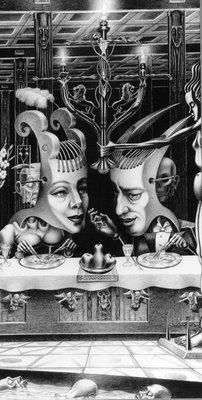
The Banquet © Irving Norman 1949 (Graphite and ink on paper).
(Click on image for larger view).
All images in this series are presented with Hela Norman's permission.
RL: All that considered, how do you explain the fact that many people, especially the young, are so strongly drawn to your work?
IN: Well these are original people, original thinkers. They have obviously had some experiences that have opened them up. Primarily my work is a criticism of the world as it is today and the people who are drawn to my work also feel this way. They have been looking for something like this. A good example of this is the show I had at the Student Union Gallery at San Jose State University. It was sensational with the students. They crowded in to see it. But one of the most interesting remarks by one of the art students was...How come we haven't seen such work before?
RL: Yes...How come? Apparently there is a larger public interest in such work, though the museum people are loathe to admit it. This is best illustrated by the George Tooker show last year at the Palace of the Legion of Honor, which was one of the most well-attended shows I have seen.
IN: Sure. The art public is hungry for such work.
More Next Time.
Previous installments of this series can be found here:
Part 1
Part 2
Interview Part 1
See Irving Norman's paintings and drawings live and in person on exhibit now in Sacramento, CA. This rare opportunity to see some of the painter's best works, at The Crocker Museum ends January 7, 2007.
Note: If you're unable to see Norman's work in person you may want to purchase a copy of the book, Dark Metropolis. It's well written and has large, clear, vivid reproductions of Norman's art.
Please respect the work of the artists you see here and be sure to credit them when you share their artwork with others.
To share your opinion on this or any other post, please click the word "COMMENTS" below.

